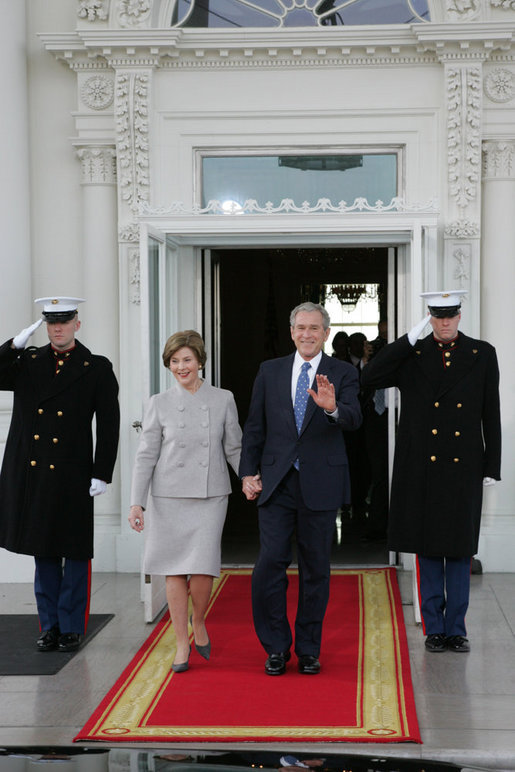Publicly available CIA reports offered no fresh incriminating evidence against Iraq, but a lot of innovative variations on the Bush Bafflegab. To wit: “Saddam will probably”; “Give him time and he will eventually”; “With sufficient weapons-grade fissile material, he’ll doubtless”; “He doesn’t have the capability to develop enriched uranium or plutonium to fuel a nuclear bomb, but hang in there…”
This is obviously not the letter of the text, but close enough to its spirit. How the CIA cobbles evidence for an “interest in acquiring” or “an effort to procure”—considering that these purchases never seem to materialize—isn’t clear. What proof do we have that they were even initiated? CIA language is manifestly intended to exempt the writer from having to substantiate much of the claims.
What a relief it was, then, when a real incriminating event finally occurred. A North Korean vessel was not allegedly—but actually—apprehended in the Arabian Sea, carrying 15 well-concealed Scud missiles. All in all, Baghdad Before Bush was suspected of hiding about 60 Scud-variant missiles. Here we had the equivalent of one-fourth of the entire Iraqi arsenal on one ship!
While Iraqi palm dates were subject to U.S.-enforced trade embargoes, it was comforting to know that North Korean Scud missiles were not. About the North Korean commitment to free trade, Donald Rumsfeld effused: They “continue to be the single largest proliferator of ballistic-missile technology on the face of the Earth, putting into the hands of many countries the technologies and capabilities which have the potential for killing hundreds of thousands of people.” Joy!
Nothing is more admirable, however, than a nation that uses its trading advantage with discretion: North Korea didn’t sell missiles to Iraq—it only sells them to “friendly nations” like Pakistan, Syria, Egypt, Iran, Libya, and Yemen, to which its latest shipment was headed.
Iraq, as the administration insisted, may have been jam-packed with Jihadists, but Yemen doesn’t exactly have to outsource for its Islamist assassins. Like America, it has plenty of homegrown homicidal talent. Recall the Yemeni port of Aden was the site of the attack on the destroyer USS Cole, which killed 17 sailors. Off the coast of Yemen, a bomb, not so long ago, damaged a French oil tanker, killing a sailor. British special forces even conducted searches for Osama bin Laden in Yemen, where al-Qaida was said to be regrouping.
The North Korean missile crisis must have left Saddam bitter about the favoritism that has allowed said nation such generous maneuverability on the axis of evil. (Although his initial frazzled reaction was probably: “Could this be something I ordered for the New Year celebrations and forgot about?”) North Korea has been welcomed out of the closet with its ongoing uranium enrichment program. And, evidently, the North Koreans are permitted to trade openly in deadly weapons, albeit with peaceniks like the Yemenites.
At the time, honorary axis member Iran, a gaily open supporter of terrorism, remained unhindered by threats of a U.S. invasion, as did the rogue states of Saudi Arabia, Syria, Libya, and Sudan. While the CIA was adamant it had no Iraqi smoking gun, evidence for these other nations’ hospitality to terrorism abounded.
As luck would have it, under the Bush Iraq Doctrine, evidence against a theory constitutes evidence for a theory. No smoking gun means there’s a hidden gun somewhere or a plan to acquire a gun, or a hidden plan to acquire a gun and hide it.
Whichever is the case, it was reason enough for an attack. Never mind that Saddam’s visibly antiquated and crumbling infrastructure was being crisscrossed and closely watched by weapons inspectors. And no matter that the U.S. was bombing him illegally—and immorally—over the unilaterally established No-Fly Zone.
More poignantly, Saddam was by then acutely aware of Washington’s not-so-secret Nuclear Posture Review. The NPR was crystal clear about this administration’s willingness to use lower-yield, precision nuclear weapons on Iraq if Saddam attacked the U.S. with nuclear, biological or chemical weapons. Washington clearly hasn’t been as dyslexic about the lessons of history as it would appear—at least implicitly, there was an acknowledgment that Cold War restraint is no folly.
Why then did this president behave as if Saladin the Second was scheming to do what the former Soviet Union didn’t dare do with its more than 10,000 strategic nuclear warheads; 30,000 nonstrategic nuclear warheads; 6,000-plus ready-to-go nuclear warheads mounted on more than 1,000 intercontinental ballistic missiles—not to mention thousands of submarine-launchable nuclear weapons and more than 1,000 nuclear bombs carried by long-range jet aircraft? (The tally is courtesy of the Independent Institute’s Robert Higgs.)
Could Saddam really have been hell-bent on doing what the many times more evil and powerful former Soviet Union avoided at all costs? Was Saddam suicidal? The facts suggested not. Given the administration’s re-embracing of the deterrence principle as articulated in the NPR, Bush’s lockjaw on Iraq didn’t make sense.
And neither was it meant to. It was meant to radically change the way we think. This was an exercise in “consciousness-raising,” befitting the permanent revolution one can expect from the ideologues in this administration.
©By ILANA MERCER
WorldNetDaily.com (Also in the Orange Country Register)
December 18, 2002
CATEGORIES: Anti-War, Bush, Foreign Policy, Iraq, Neoconservatism, War

 print
print